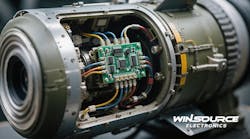Obsolescence Management in Aerospace and Defense Electronics
This mismatch creates a persistent technical challenge: obsolescence. If not managed properly, obsolescence can lead to escalating support costs, project delays, and, in extreme cases, mission-critical system failure.
With increasingly complex global supply chains and accelerated product turnover among semiconductor manufacturers, obsolescence management has become a core discipline in safeguarding the long-term operability of aerospace and defense systems.
The Obsolescence Landscape in Defense Electronics
In aerospace and defense systems, the obsolescence of electronic components constitutes a highly predictable lifecycle risk and is virtually unavoidable. Platforms such as fighter aircraft, missile systems, satellites, and naval vessels are designed for operational lifespans measured in decades. In contrast, electronic component manufacturers—driven by the fast-paced consumer market—frequently discontinue products within just a few years. According to a report by the U.S. Government Accountability Office (GAO), a significant proportion of critical electronic components in defense systems face end-of-life (EOL) or diminished manufacturing sources (DMS) risks shortly after deployment.
These challenges are particularly acute in mission-critical applications:
- Qualification of alternative components can be time-consuming and costly;
- Firmware or software may need to be re-engineered due to pin incompatibility;
- Overstocking can lead to degradation and inventory quality concerns.
Industry Frameworks: From DMSMS to Predictive Management
To address component obsolescence, the U.S. Department of Defense and its contractors have long implemented DMSMS (Diminishing Manufacturing Sources and Material Shortages) frameworks. Standards and guidance from agencies such as the Defense Logistics Agency (DLA) and SAE International (e.g., GEIA-STD-0005) provide structured approaches to mitigation.
Key practices include:
- BOM Risk Assessment: Leveraging tools like SiliconExpert and IHS CAPS to evaluate lifecycle risk during the design phase;
- Lifecycle Monitoring: Tracking component status, EOL announcements, and PCNs (Product Change Notifications);
- Alternative Component Planning: Pre-identifying form, fit, and function-compatible options and validating feasibility;
- Procurement Planning: Coordinating reliable sourcing before production ends, and storing components under qualified conditions;
- Authorized Sourcing Verification: Ensuring traceable, verified supply chains to prevent counterfeits and meet military specifications.
Response Strategies: From Design to Supply Chain Integration
While traditional processes remain vital, modern obsolescence management requires a more agile, data-driven, and cross-functional approach. Leading defense electronics manufacturers commonly adopt the following practices:
- Designing for Long-Term Maintainability
- Modular architectures that allow subsystem upgrades;
- Adoption of programmable devices such as FPGAs to reduce dependence on ASICs;
- Standardized interfaces like VITA or OpenVPX to improve compatibility.
- Strategic Inventory and Lifecycle Forecasting
- Establishing alerts through lifecycle analytics platforms;
- Collaborating with distributors for ESD-safe storage and long-term warehousing;
- Using digital twins and simulation tools to assess obsolescence's impact on system performance.
- Supply Chain Coordination
- Negotiating extended supply agreements or die banking with manufacturers;
- Participating in risk intelligence platforms such as GIDEP;
- Embedding obsolescence response protocols into supplier contracts and design documentation.
As systems grow in complexity and mission timelines lengthen, distributors are evolving from transactional vendors into lifecycle partners. Distributors with fast response capabilities, transparent data systems, and robust cross-referencing tools now play a critical role in supporting defense and aerospace programs through EOL transitions and supply continuity.
WIN SOURCE, a global electronic component distributor specializing in high-reliability sectors, ranks 13th on Supply Chain Connect's 2025 list of the Top 50 Global Electronic Component Distributors. WIN SOURCE offers comprehensive solutions spanning lifecycle management, global sourcing, obsolete component management, and alternative solutions. These services help defense and aerospace customers mitigate design rework and performance risk while ensuring long-term platform availability.
Conclusion: Building Strategic Obsolescence Resilience
In today's aerospace and defense landscape, obsolescence is no longer just a supply chain issue—it is a challenge in system engineering, design, and lifecycle coordination. Organizations must embed obsolescence resilience into their component strategies, supported by predictive intelligence and collaborative ecosystems, to ensure continuity, compliance, and mission assurance across the system lifecycle. Reprinted from WIN SOURCE ELECTRONIC-NEWS © 2025 Win Source Electronics. All rights reserved. This content is protected by copyright and may not be reproduced, distributed, transmitted, cached or otherwise used, except with the prior written permission of Win Source Electronics.
